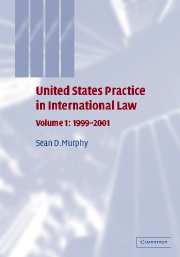Book contents
- Frontmatter
- Contents
- Foreword by Judge Thomas Buergenthal
- Acknowledgments
- Table of Periodical Abbreviations
- Table of Cases
- Table of U.S. Statutes
- Table of Treaties
- I General International and U.S. Foreign Relations Law
- II State Diplomatic and Consular Relations
- III State Jurisdiction and Immunities
- IV State Responsibility and Liability
- V International Organizations
- VI International Law and Nonstate Actors
- VII International Oceans, Environment, Health, and Aviation Law
- VIII International Economic Law
- IX International Human Rights
- X International Criminal Law
- XI Use of Force and Arms Control
- XII Settlement of Disputes
- XIII Private International Law
- Annex
- Index
I - General International and U.S. Foreign Relations Law
Published online by Cambridge University Press: 10 December 2009
- Frontmatter
- Contents
- Foreword by Judge Thomas Buergenthal
- Acknowledgments
- Table of Periodical Abbreviations
- Table of Cases
- Table of U.S. Statutes
- Table of Treaties
- I General International and U.S. Foreign Relations Law
- II State Diplomatic and Consular Relations
- III State Jurisdiction and Immunities
- IV State Responsibility and Liability
- V International Organizations
- VI International Law and Nonstate Actors
- VII International Oceans, Environment, Health, and Aviation Law
- VIII International Economic Law
- IX International Human Rights
- X International Criminal Law
- XI Use of Force and Arms Control
- XII Settlement of Disputes
- XIII Private International Law
- Annex
- Index
Summary
OVERVIEW
During 1999–2001, in the waning years of the administration of William J. Clinton, the United States remained actively engaged in the use of international law and international institutions to advance the interests of the United States. The Clinton administration focused strongly on use of international law and institutions to promote the economic interests of the United States, both in containing severe global market turmoil during this period and in aggressively fighting foreign trade barriers. The administration successfully negotiated trade agreements with Jordan, Vietnam and China, but Congress did not grant “fast-track” authority for more ambitious trade negotiations. With the World Trade Organization still in its early years, the United States pursued dispute settlement before the WTO on matters such as bananas and hormone-treated beef, while at the same time seeking to fend off challenges relating to U.S. tax benefits for its “foreign sales corporations” and other matters. The Clinton administration also sought to use multilateral institutions in a range of areas, including to provide debt relief for the most poor nations and to combat the AIDS epidemic in Africa.
Where feasible, the Clinton administration also built its foreign policy around notions of advancing the rule of law, human rights, and democracy worldwide, placing great emphasis on supporting the ad hoc international criminal tribunals; developing creative ways of compensating victims of human rights abuses that occurred during the Second World War; using the United Nations to impose economic sanctions on “rogue states”; signing treaties relating to the rights of children; and implementing existing human rights treaties through legislation and reporting.
- Type
- Chapter
- Information
- United States Practice in International Law , pp. 1 - 16Publisher: Cambridge University PressPrint publication year: 2003



